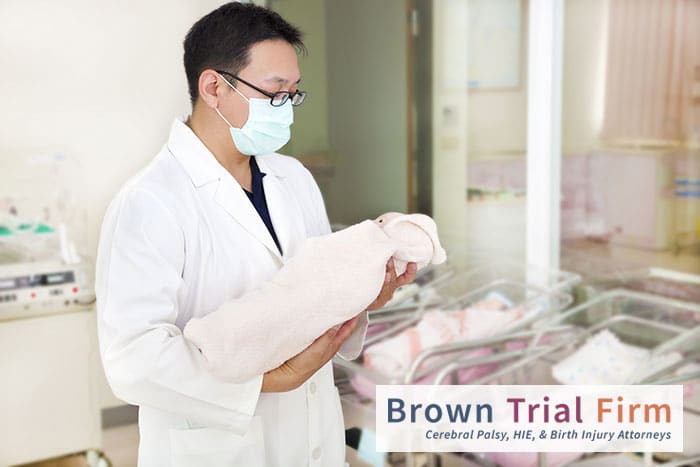With top-of-the-line hospitals like Baptist Health Medical Center and UAMS Medical Center, parents in Little Rock, Arkansas, have plenty of choices when it comes to where they want to deliver their babies. Unfortunately, even with all the latest technologies and innovations these facilities have to offer, medical mistakes and birth injuries still happen.
Welcoming a new life into the world is a joyous occasion for parents, but when that joy is overshadowed by the devastating news of a birth injury, the emotional and financial toll on families can be overwhelming. Parents of children with birth injuries often find themselves navigating uncharted waters, dealing with immense stress as they seek the best care and support for their little ones.
The reality is that costs associated with medical treatments, therapies and specialized care can quickly add up, placing a significant burden on a family’s finances. Families may find themselves facing mounting medical bills, out-of-pocket expenses, and the need to modify their homes and lifestyles to accommodate their child’s unique needs.
During this difficult time, it’s completely normal to feel overwhelmed and unsure of where to turn for help, but you don’t have to face these challenges alone. If your child’s birth injury resulted from medical negligence, seeking legal representation can provide you with the support you need to get help for your child, not just today but well into the future.
At Brown Trial Firm, we understand the emotional and financial hardships parents face when caring for a child with a birth injury. That’s why Little Rock birth injury attorney Laura Brown has dedicated her practice to helping families like yours pursue justice and compensation for their child’s injuries. She’ll work tirelessly to hold those responsible accountable and secure the financial resources needed to provide the best possible care and support for your child.
Statistics on birth rates and infant mortality in Arkansas
In 2020 alone, there were more than 35,000 live births in Arkansas, which amounts to a fertility rate of 60.7 per 1,000 women ages 15 to 44. That’s slightly higher than the national fertility rate that year of 56.0.
Additionally, Arkansas ranks as the second-worst state for teen birth rates, with Mississippi coming in at number one. According to an article in the Arkansas Times, Arkansas teens gave birth at a rate of nearly 28 per 1,000 in 2020, which is significantly higher than the national average of 15.4.
According to the Centers for Disease Control and Prevention (CDC), the infant mortality rate in Arkansas was 7.3 deaths per 1,000 live births in 2020, with a total of 260 infants dying that year. By contrast, the infant mortality rate across the entire U.S. was only 5.4 deaths per 1,000 births that same year.
Clearly, there’s still a lot of work to be done to ensure that mothers and babies in Little Rock receive the best possible care during pregnancy, labor and delivery to prevent these tragic deaths from occurring.
What are the most common birth injuries?
A birth injury is a type of injury suffered by a newborn during the process of labor and delivery. These injuries can range from mild to severe and may result in physical or neurological damage. Birth injuries can be caused by various factors, including medical negligence, difficult labor, improper use of delivery tools and other complications during childbirth.
Some of the most common birth injuries include the following:
- Cerebral palsy. Cerebral palsy is a disability that affects a person’s ability to control their muscles and movements. It results from a brain injury, often caused by a lack of oxygen during labor or birth.
- Erb’s palsy. Erb’s palsy is a condition caused by overstretching of the brachial plexus nerves found in the arms, shoulders and neck. Too much strain can lead to nerve damage and even paralysis in the affected area.
- Broken bones. Fractures can happen during delivery if a baby is large for gestational age or in an abnormal delivery position (such as breech). The most likely body parts to experience trauma and a fracture are the arm, shoulder, hip, collarbone and skull.
- Intracranial hemorrhage. A baby can suffer a hemorrhage, also known as a brain bleed, within the skull or behind the eyes as a result of factors such as prolonged labor, premature birth, the use of forceps or a vacuum extractor, or an abnormal position during delivery.
- Caput succedaneum. Caput succedaneum involves swelling and bruising of the scalp, usually caused by assistive birth devices like forceps. It isn’t life-threatening and usually clears on its own.
- Cephalhematoma. Cephalohematoma is also frequently caused by forceps or vacuum extraction but results in bleeding under the baby’s cranial bone. Usually, it resolves on its own, but it can lead to other complications if it isn’t properly managed.
- Spinal cord injuries. Spinal cord injuries are among the most serious birth injuries. A baby can suffer temporary or permanent neurological disorders or even paralysis.
Depending on the circumstances, some of these birth injuries can be temporary or permanent and mild, moderate or severe.
What is negligence in a birth injury lawsuit?
Birth injury lawsuits are based on negligence, and not every birth injury is the result of a medical mistake. Negligence occurs when a doctor, nurse or other medical professional fails to meet the standard of care that a reasonable medical professional in the same position would provide.
Medical negligence and mistakes that result in babies suffering birth injuries amount to medical malpractice, which gives parents the right to file a birth injury lawsuit.
What are the top medical errors that cause birth injuries?
Learn about the most common medical errors that lead to birth injuries and how they can be prevented.
Who is typically liable in a birth injury lawsuit?
My baby was injured during delivery; how do I know who’s responsible?
There are different potential liable parties in a birth injury lawsuit, including doctors, nurses, midwives, pharmacists and even hospitals. In many cases, the doctor is the primary party liable for the negligence that causes an infant to suffer injuries.
A doctor’s liability in a birth injury lawsuit is based on the legal principle of medical malpractice. In the context of birth injuries, a doctor may be held liable if their actions or omissions during prenatal care, labor or delivery deviated from the accepted medical standard, leading to harm or injury to the mother or the baby.
Common examples of a doctor’s liability in birth injury cases include:
- Failure to diagnose or adequately manage maternal health conditions during pregnancy that impact the baby’s well-being
- Errors during labor and delivery, such as improper use of delivery instruments like forceps or vacuum extractors
- Failure to recognize signs of fetal distress and take appropriate action promptly
- Incorrect administration of medication or anesthesia during childbirth
- Delayed or improper response to complications that arise during childbirth
Additionally, manufacturers of faulty medical equipment or drugs used during childbirth could also be held accountable in certain cases.
Determining liability requires a thorough investigation and the expertise of an experienced birth injury attorney to build a strong case for the injured child and their family.
Pitocin birth injuries & medical negligence claims
Did your baby suffer a birth injury after you received pitocin during labor or delivery? Learn if their injury could be the result of medical malpractice.
What compensation is available through a birth injury lawsuit?
Compensation for various damages can be recovered in a successful birth injury lawsuit. They include the following:
- Medical expenses
- Home health and other assistive care
- Assistive devices and equipment
- Home modifications
- Respite care
- Physical and occupational therapy
- Scarring and disfigurement
- Mental anguish, pain and suffering, and emotional distress
- Specialized educational needs
- Loss of capacity to earn a living
Total compensation amounts vary according to the individual circumstances of your child’s case but should include both past and future medical care and related expenses.
Is there a cap on medical malpractice damages in Arkansas?
Arkansas does not place a cap on medical malpractice damages.
This means that there is no limit to the amount of compensation you can be awarded through a birth injury lawsuit in Arkansas.
What is the statute of limitations on birth injuries in Arkansas?
The statute of limitations for a birth injury lawsuit in Arkansas is different from other medical malpractice lawsuits in the state, which is generally 2 years from the date of injury. For any injuries that happen to children under 9 years old, you have until the child’s 11th birthday to file a birth injury lawsuit in Arkansas.
How the Arkansas Charity Immunity Doctrine can impact a birth injury lawsuit in Little Rock
The Arkansas Charity Immunity Doctrine exists to protect certain nonprofit hospitals and medical facilities from medical malpractice lawsuits. This is in place to prevent the charity from losing assets by having to pay for damages incurred in a lawsuit. However, in some cases, the charity’s insurance company can be held liable in a birth injury lawsuit so that parents of injured babies can still recover damages.
A birth injury attorney can advise you of your rights and options if your baby suffered an injury at a nonprofit hospital in Arkansas.
Contact an experienced Little Rock birth injury lawyer
Birth injuries can lead to serious disabilities that require a lifetime of treatment and care. If you believe your child suffered a birth injury because of medical negligence, you owe it to yourself and your child to get the compensation they need to live their life to the fullest.
If you have any questions about the birth injury lawsuit process or want help filing your claim, contact Little Rock and Dallas birth injury attorney Laura Brown at Brown Trial Firm. Laura has years of experience in birth injury law, helping families like yours in Arkansas, Texas, and all across the U.S. get the compensation they deserve.
Contact her today for a free consultation of your case.
References
Centers for Disease Control and Prevention. (2020, September 10). Infant mortality. Centers for Disease Control and Prevention. https://www.cdc.gov/reproductivehealth/maternalinfanthealth/infantmortality.htm
Fertility rate: Arkansas, 2010-2020. (n.d.). March of Dimes | PeriStats. Retrieved July 19, 2023, from https://www.marchofdimes.org/peristats/data?reg=99&top=2&stop=1&lev=1&slev=4&obj=1&sreg=05
Hennigan, M. (2022, October 11). Study finds Arkansas teen birth rate is second worst in the country, nearly double national rate. Arkansas Times. https://arktimes.com/arkansas-blog/2022/10/11/study-finds-arkansas-teen-birth-rate-is-second-worst-in-the-country-nearly-double-national-rate
Stats of the States – Infant Mortality. (2022, September 30). Www.cdc.gov. https://www.google.com/url?q=https://www.cdc.gov/nchs/pressroom/sosmap/infant_mortality_rates/infant_mortality.htm&sa=D&source=docs&ust=1689781763781694&usg=AOvVaw0KHdvW7KDwNIOskQ8ZBQSX




